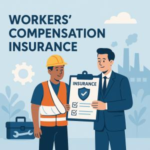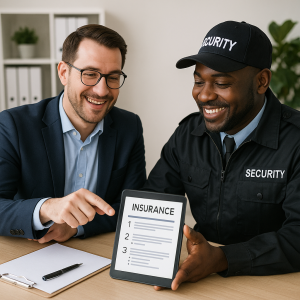
Self-Insured Workers Compensation: Pros, Cons and Eligibility Tests
August 20, 2025
Unarmed Guard Workers’ Comp Rate Benchmarks in Georgia for 2024
August 20, 2025In the security industry, ensuring the safety adn well-being of security guard personnel is paramount-not only from a humanitarian perspective but also as a critical buisness imperative. Workplace injuries can result in significant financial losses, operational disruptions, and reputational damage. Implementing effective workers’ compensation loss control strategies is essential to mitigate these risks. this article explores how cultivating a robust culture of safety within security guard organizations can drive measurable improvements in incident prevention, reduce claims frequency and severity, and ultimately safeguard both employees and organizational assets. By embedding safety principles into daily operations and leadership practices, security firms can enhance employee engagement, operational continuity, and long-term profitability.
Table of Contents
- Understanding Common Risks in Security Guard Operations and Methods to Mitigate Them
- Implementing Comprehensive Training Programs to Enhance Safety Awareness
- Leveraging Technology and Equipment to Reduce workplace Injuries
- Fostering Employee engagement and Leadership Commitment to build a strong Safety Culture
- Q&A
- To Conclude
Understanding common Risks in Security Guard Operations and Methods to Mitigate them
Security guard roles inherently involve various risks, ranging from physical confrontations to environmental hazards. Common threats include slip-and-fall incidents, assaults by intruders, and exposure to hazardous materials during patrols. Additionally,fatigue and inadequate interaction tools can severely compromise a guard’s effectiveness and safety. Recognizing these hazards early and integrating proactive measures such as comprehensive site assessments,regular safety drills,and advanced training programs are essential to reduce incident rates substantially.Employing technology such as body-worn cameras and real-time monitoring systems also enhances situational awareness, allowing for quicker responses and risk de-escalation.
Mitigation strategies must be a cornerstone of operational planning and are best upheld through a culture deeply embedded with safety values. Organizations should enforce stringent personal protective equipment (PPE) policies, conduct ergonomic assessments to minimize physical strain, and implement clear reporting mechanisms that encourage guards to voice safety concerns without fear of reprisal. Below is a summary table highlighting critical risks alongside targeted mitigation practices for easy reference:
| common Risks | Mitigation Methods |
|---|---|
| Physical Assault | Conflict resolution training, body cameras |
| Slip and Fall | Regular site maintenance, anti-slip footwear |
| Fatigue | Shift rotations, mandatory breaks |
| Poor Communication | Updated tech tools, communication protocols |
Implementing Comprehensive training Programs to Enhance Safety Awareness
To foster a resilient safety culture among security personnel, it is indeed essential to develop targeted training programs that go beyond basic compliance. These initiatives must be multifaceted, incorporating practical exercises, scenario-based learning, and frequent safety refreshers to ensure continuous engagement and retention. Emphasizing real-world risks specific to the security industry-such as conflict de-escalation techniques, hazard recognition, and emergency response protocols-equips guards with the tools needed to proactively mitigate workplace injuries and associated costs.
Key components of an effective training program include:
- Customized modules tailored to job roles and environments
- Interactive workshops and hands-on drills
- Regular assessments to identify knowledge gaps
- Utilization of technology such as e-learning platforms for accessible ongoing education
- Leadership involvement to reinforce a top-down commitment to safety
| Training Aspect | Benefit |
|---|---|
| Scenario Simulations | Enhances decision-making under pressure |
| Safety Refresher Sessions | Maintains high awareness and compliance |
| Role-Specific Modules | Addresses unique risks relevant to duties |
| Feedback Mechanisms | Encourages continuous advancement |
Leveraging Technology and Equipment to Reduce Workplace injuries
Implementing advanced technology and modern equipment plays a crucial role in minimizing the risk of workplace injuries among security guards. By integrating tools such as body-worn cameras, mobile communication devices, and automated incident reporting systems, organizations can enhance situational awareness and streamline emergency responses. These technologies empower guards to remain vigilant while reducing physical strain, thereby decreasing the likelihood of accidents. Additionally,ergonomic equipment,such as adjustable duty belts and supportive footwear,helps alleviate musculoskeletal issues that are common in physically demanding security roles.
Key technological and equipment strategies include:
- Deployment of real-time monitoring systems for hazard detection.
- Use of GPS-enabled devices to ensure rapid support during emergencies.
- Regular maintenance and upgrades of personal protective equipment (PPE).
- Incorporation of wearable health monitors to track fatigue and stress.
| Technology/Equipment | Safety Benefit | Implementation Impact |
|---|---|---|
| Body-Worn Cameras | Enhances accountability and evidence collection | Reduced incident disputes by 35% |
| Ergonomic Duty Gear | Minimizes strain and fatigue | Decreased reported aches by 28% |
| Automated Incident Reporting | Speeds documentation and response | Response time improved by 22% |
Fostering Employee Engagement and Leadership Commitment to Build a Strong Safety Culture
Engaging employees at all levels is essential for cultivating a workplace where safety is not just a protocol but a shared value. Leaders who visibly demonstrate their commitment to safety set the tone for the entire organization, encouraging proactive participation and ownership among security personnel. Regular safety briefings, open forums for hazard reporting, and recognition programs for safe behavior reinforce this commitment. When employees feel heard and valued in their safety concerns, they become active partners rather than passive participants in loss control efforts.
Key strategies to foster engagement and leadership dedication include:
- Leadership walk-throughs focusing exclusively on safety observations and feedback
- Establishment of cross-functional safety teams that empower employees to influence policies
- Incorporation of safety performance metrics into leadership evaluations
- continuous education programs highlighting the link between leadership actions and frontline safety outcomes
| Leadership Action | Employee Impact | Resulting Safety Outcome |
|---|---|---|
| Monthly safety Walks | Increased hazard awareness | 30% reduction in near-misses |
| Safety Suggestion Incentives | Higher proactive reporting | Improved hazard mitigation |
| Leadership Safety Training | Better support for frontline needs | Enhanced trust and morale |
Q&A
Q&A: Security Guard Workers’ comp Loss Control – Creating a Culture of Safety
Q1: Why is workers’ compensation loss control critical for security guard companies?
A1: Workers’ compensation loss control is essential in the security industry because security guards face unique risks, including physical confrontations, slips, trips, and exposure to hazardous environments. Effective loss control reduces workplace injuries, decreases claim costs, and enhances overall operational efficiency, protecting both employees and the company’s financial health.
Q2: What are the key components of an effective safety culture in the security workforce?
A2: An effective safety culture includes leadership commitment, consistent safety training, open communication about hazards, employee involvement in safety programs, regular risk assessments, and prompt incident reporting.This fosters an surroundings where safety is prioritized and continuously improved.
Q3: How can security firms proactively identify risks to reduce workers’ comp claims?
A3: Proactive risk identification involves conducting thorough job hazard analyses, reviewing past injury and claim data, engaging frontline employees for insights, and implementing routine site inspections. These steps enable early detection of potential hazards and facilitate timely mitigation measures.
Q4: What role does employee training play in loss control for security guards?
A4: Training is pivotal to loss control as it equips security guards with knowledge and skills to handle risks safely, recognize danger signs, and respond appropriately to incidents. Regular, scenario-based training improves awareness and reinforces safe behavior.
Q5: How can management demonstrate commitment to safety to influence employee behavior?
A5: Management can demonstrate commitment by integrating safety goals into performance metrics, allocating resources for safety programs, participating in training sessions, recognizing safe practices, and maintaining transparent communication about safety issues. Visible leadership involvement encourages employee buy-in.
Q6: What strategies help ensure continuous improvement in safety protocols?
A6: Continuous improvement is driven by regular safety audits, analyzing incident reports and near misses, soliciting employee feedback, updating training materials to address emerging risks, and benchmarking against industry best practices.This iterative process maintains high safety standards.
Q7: How does creating a culture of safety impact workers’ compensation costs?
A7: A strong safety culture reduces the frequency and severity of workplace injuries, resulting in lower workers’ compensation claims and premiums.It also minimizes downtime and improves employee morale, contributing to overall cost savings.
Q8: What technology solutions can support loss control efforts in the security industry?
A8: technology such as mobile safety apps,incident reporting software,video surveillance with analytics,and wearable safety devices can enhance hazard monitoring,streamline reporting,and provide data-driven insights to improve safety management.
Q9: How critically important is employee involvement in sustaining a safety culture?
A9: Employee involvement is critical as frontline workers are frequently enough the first to recognize hazards and suggest practical solutions. Encouraging their participation in safety committees and decision-making processes increases engagement and accountability.
Q10: What is the first step security companies should take to establish a culture of safety?
A10: The first step is gaining leadership buy-in to prioritize safety as a core organizational value. this foundation enables the development and consistent enforcement of safety policies, allocation of necessary resources, and cultivation of employee trust and participation.
To Conclude
fostering a culture of safety within the security guard workforce is essential for effective workers’ compensation loss control. By prioritizing comprehensive training, proactive risk management, and ongoing communication, organizations can significantly reduce workplace injuries and associated costs. Investing in safety not only protects employees but also enhances operational efficiency and reinforces organizational reputation. Ultimately, a steadfast commitment to safety culture empowers security firms to mitigate risks, improve employee well-being, and achieve lasting business success.
“This content was generated with the assistance of artificial intelligence. While we strive for accuracy, AI-generated content may not always reflect the most current information or professional advice. Users are encouraged to independently verify critical information and, where appropriate, consult with qualified professionals, lawyers, state statutes and regulations & NCCI rules & manuals before making decisions based on this content.







